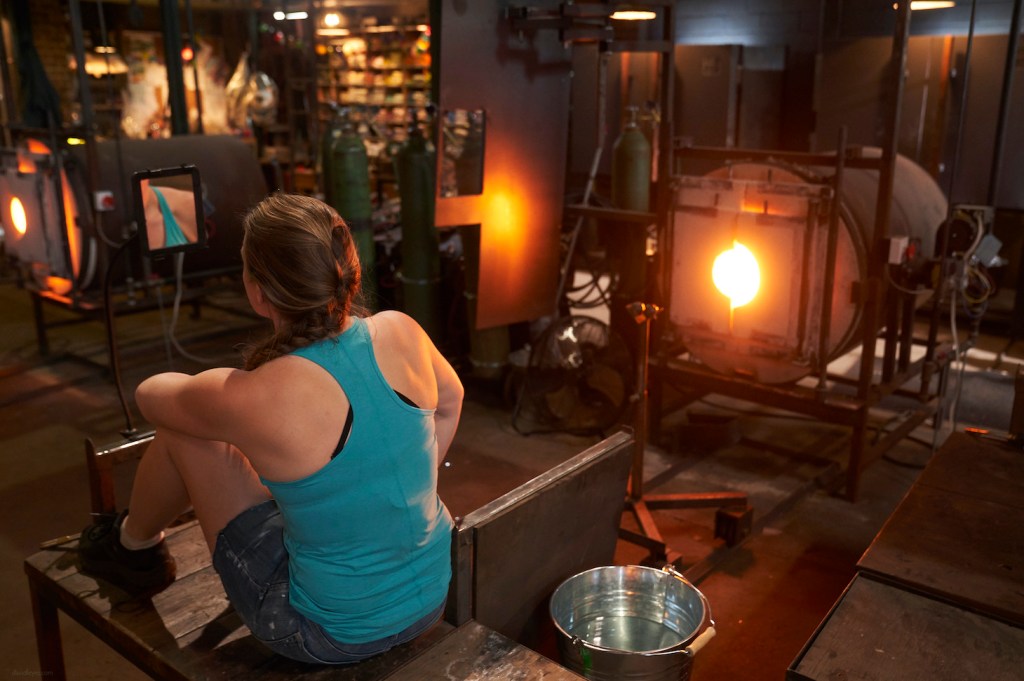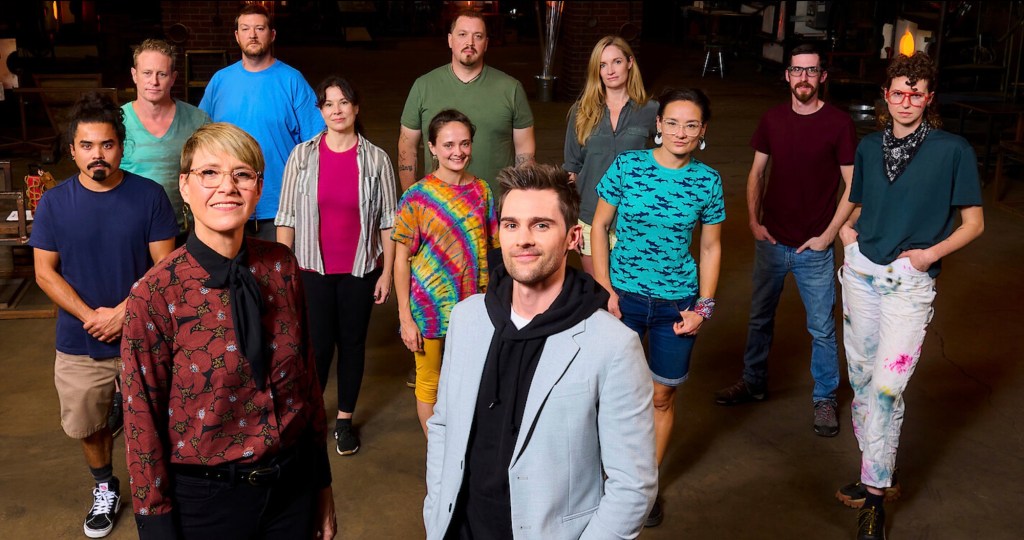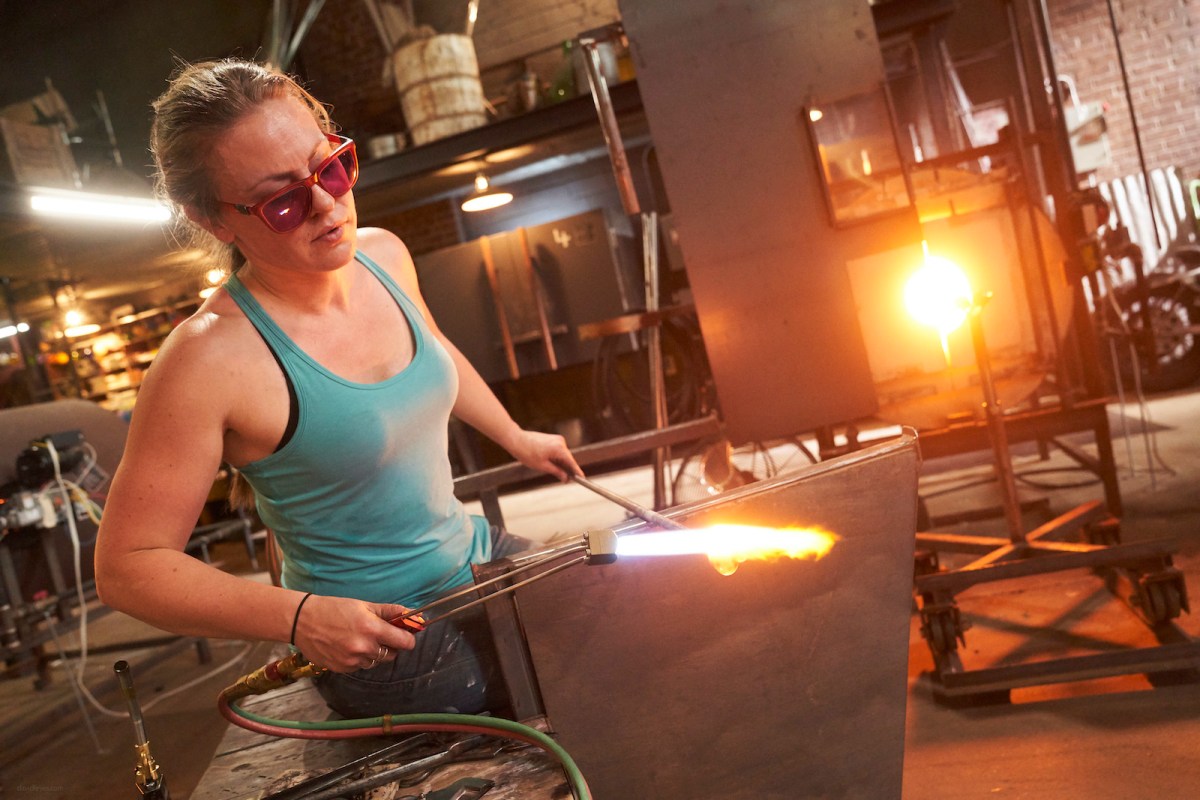Tegan Hamilton vacillated at first, and then said no to Netflix.
But the now Melbourne-based glass blower was able to quell her disappointment when she was offered a place on Series 2 of Blown Away, a reality TV show that puts creativity on the line, pitting glass blowers against each other.
‘I was working with Martin Blank in Seattle, and they asked him who might be good for the first season,’ Hamilton told ArtsHub. ‘He suggested me. But I was a bit cautious. The Reality TV genre can ruin your whole life, so I declined, and then it turned out to be incredibly successful.’
Hamilton didn’t hesitate to put her name forward for round two.
Read: How to be creative with confidence
‘I talked about being an Australian, and playing footy and weird quirks about me … and they called me within a day.’
Filmed in Canada, Blown Away takes viewers in to the glass ‘hotshop’ to become intimate with the machinations of blowing glass in a competitive format.
It is not the first creative Reality TV show. The Great Pottery Throw Down was aired by BBC Two in 2015. A fifth series aired on HBO Max earlier this year (January 2022).
Months later, in July this year, Blown Away delivered a third series, and with ratings still good. Its first series made Netflix’s top 10, and a rating of 7.1 on IMDB. Auditions for a fourth season have already begun, and it is expected to be aired in 2023.
Like many in the glass community – which is international and collegiate by nature – Hamilton had been living in Seattle for seven years when Blown Away started casting.
‘I moved there in 2013 with two suitcases no place to live and no job,’ Hamilton said. ‘I got straight off the plane and went to Martin’s studio and he gave me work … I also got work at Seattle Glassblowing Studio teaching ‘blow-your-owns’.
Read: Understanding the year of glass in 2022
One criticism the series received – especially after that first run – was that it was North America-centric. Seattle is a global glass town, so was it just an oversight of producers? And how was that criticism a win for an Australian?
How a Reality TV show boosted my visibility
When asked whether the arts was a good fit for Reality TV, and whether it had booster her career, Hamilton said that within that month of first screening, her Instagram follows shot up by an extra six thousand.
‘That ability to show my work to a broader audience is just incredible,’ she told ArtsHub.
‘I think every extra hundred followers gives more exposure, which gives more sales, which – while not directly selling through the show – was an indirect impact that it had.
Read: This is why you can’t stop watching ‘bad’ TV
‘Of course, that exposure was a double-edged sword,’ Hamilton continued. ‘I did not perform to my expectations or get to show what I could do. I had a rough day; I got sick with heat stroke and lost so much time.
‘It was really difficult to have a bad day and have that as the representation of you. It is the same in sports.’
Hamilton has been working with glass since 2004, and is known for sculpting hot glass. However, her TV career was blown short, getting knocked out in the first round.
The resulting visibility has had long tendrils, however. Hamilton recalled being in the pub after a Friday footy game and being recognised.
‘I was talking to this bloke and his friend said, “Weren’t you on Blown Away? Can I get a photo with you, my girlfriend is a huge fan of the show”. It’s so weird. This was a footy head at the pub, not an art audience,’ she said.
‘I tell people I was on Netflix and they are like “oh yeah”. But then I tell them I am an official Giff [marketing the series] and that is way more impressive to them than Netflix,’ she laughed. ‘I have even found my Giff on [the dating app] Bumble.’
What about psychologically – what are the pros and cons?
Hamilton explained that part of the selection process involved a psychological evaluation.
‘They make sure you are prepared for the whole process, that you are equipped to deal with the day-to-day [of Reality TV living and competing] but also the other part – helping you deal with internet trolls.’
She got off pretty easy – just one. ‘To have thousands of positive messages and just one jerk was pretty good.’ Her advice is just not to read social feeds, not to go searching and lose yourself in the spiral of comments.
Read: ‘I hated it so much’ – Byron Baes is upsettingly bad
The great knock was having to deal with her early exit and what that might mean in terms of her career.
One day doesn’t make you a success or failure.
Tegan Hamilton, glass artist
‘I made a bunch of little ‘unbearable bears’, these are the bears that haunt me! It was quite cathartic, and I sold a few of those around the world.
‘I didn’t want to ignore everything that happened. It was important for me to talk about it,’ said Hamilton. ‘I don’t feel positive about it; it is not what I wanted to achieve.’

Searching for a ‘type’
One of the weirdest things about being on a Reality TV, Hamilton revealed, was having to get her wardrobe approved. ‘You had to have 10 different hotshop outfits and 10 presentation outfits; they couldn’t have stripes, they couldn’t have logos [logo T-shirts are big in the glass community].’
Hamilton realised just how much they were creating an image or profile when first meeting her fellow contestants, after being sequestered in the hotel before filming. Up to that point, Hamilton had been in in a kind of lockdown, allowed to go to the hotel gym supervised for just half-an-hour a day (she is also a personal trainer).
‘When I finally met the other contestants, the guys said, “you got to go to the gym!” and that they didn’t. Clearly, [the producers] wanted me to get a bit pumped, and that made me realise that was a big part of the persona they created.’
When asked how the Australian glass community responded to her selection, Hamilton said: ‘I did have some conversations with a couple of glassies and got a sense that they were frustrated they didn’t get on [the show].
Read: Do glass prizes give the full picture?
‘But a lot of it comes down to personality. Maybe I have the look they wanted to personify an Australian in their eyes – the fact that I was a personal trainer at the time, played footy and had blonde hair. They use all that in the show.’
As well as being a personal trainer, Hamilton has been a cake decorator and a bra fitting specialist. She plays Australian Rules football, and grew up in country Victoria. It’s a great narrative.
A clear demonstration of that mix of reality and Reality TV is the choice of hosts for the series: Katherine Gray is a respected glass artist and associate professor at California State University; co-host Nick Uhas is a former Big Brother USA contestant and science YouTuber.

Does Reality TV offer a realistic snapshot?
Hamilton said that while Blown Away, ‘has meant that glass is a bit more at the forefront, and people understanding what glass is’, one criticism was the lack of holistic view of the glass community – in particular cold working, in which some glass artists specialise.
‘There is more process involved than just five hours in hotshop; to omit coldworking as an important part of that process is slightly problematic in process of understanding,’ she told ArtsHub.
‘There is Reality TV here, and there is Reality TV in America. Here it is a bit different. There is an over-the-topness in the American style,’ said Hamilton.
Everyone has an idea of what Reality TV is, but this show, being in the arts space, had a more favourable view.
Tegan Hamilton
She added that because Blown Away was a Netflix production, it has longer legs. ‘Netflix is more permanent platform. It’s not like a documentary that comes out and is gone. People can watch it on the platform for the next five to 10 years.’
That also has a career implication. It is ‘sticky’ on a moment of a career.
On the official blurb, Hamilton said that her dream entering the competition was to ‘blow glass full-time’. She corrected: ‘I have made glass full-time for a long time, but not my own glass.’
Hamilton is still doing contract assisting work for different ‘glassies’, but she has also diversified her career. Lockdown kept her out of the hotshop, so she turned to painting. She is also working as an operations manager for Artistic Solutions Group, which facilitates artists needs – managing websites, producing projects for artists and bridging to commercial opportunities.
‘It means that I am not just relying on busting out all that money to make glass. If I could sell, I would blow glass five days a week,’ said Hamilton acknowledging how small the market is in Australia – Blown Away status or not.
What about the timing and filming in a pandemic?
Series 2 was filmed in March 2020 when COVID hadn’t quite got its claws into Canada.
‘The filming happened and then I went back to Seattle and was feeling pretty vulnerable; you are going through a very deep experience but you can’t speak to people about it due to NDAs (Non Disclosure Agreements). And then that was followed by isolation with COVID.’
Hamilton started to make clay works and paintings in her living room to try to process what she was feeling.
It took her about six months to get a flight back to Australia. ‘I had lots of cancelled flights and ended up having to get a Business Class flight,’ she said but remained positive regarding the overall experience.
Season 2 of Blown Away was eventually released on Netflix in January 2021.
The winner of each series wins a prize package worth the equivalent of $60,000, including an artist residency at the prestigious Corning Museum of Glass in New York.
There is no news yet whether an Australian glass artist will join the next crop of contestants for Season 4 (2023 release).





